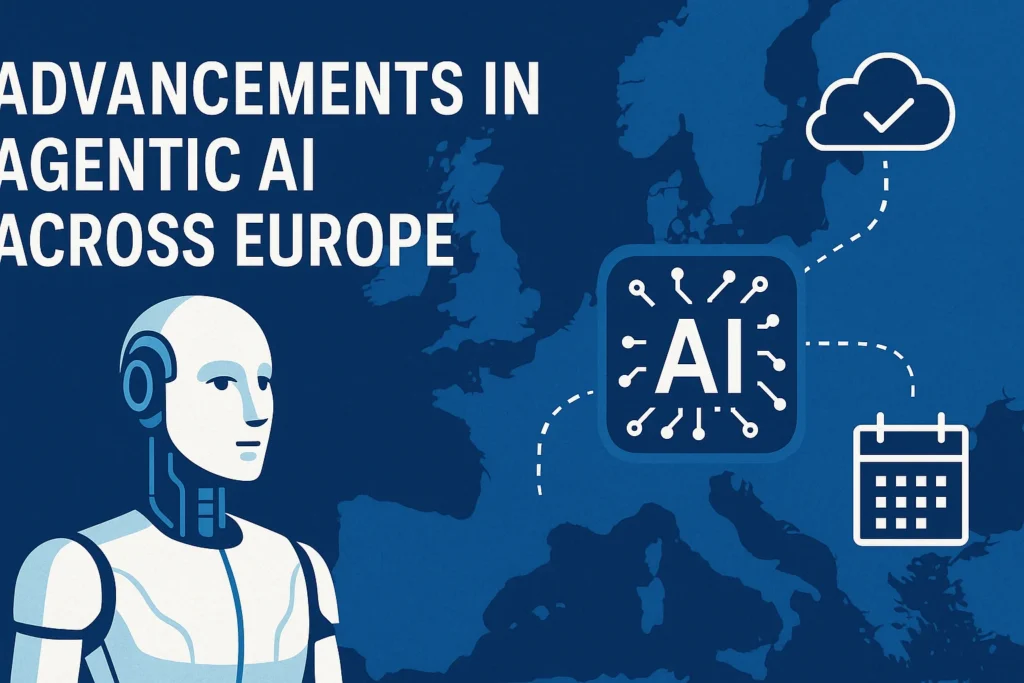On a rainy Tuesday in Munich, the city’s central hospital AI did something extraordinary—it completely reorganized the surgical schedule for 47 operations across multiple departments. What made this remarkable wasn’t just the complexity of the task, but that:
✔ No human initiated the changes
✔ The AI considered 23 variables (from staff fatigue to equipment sterilization)
✔ It documented every decision for regulators
This is Agentic AI—Europe’s bold leap beyond chatbots and copilots into artificial intelligence that can perceive, decide, and act autonomously. While Silicon Valley races toward artificial general intelligence (AGI) and China pushes state-controlled systems, Europe is carving a third path—one where AI gains measured autonomy within strict ethical guardrails.
From Barcelona’s self-optimizing traffic grids to Helsinki’s education bots that personalize lessons in real-time, Europe is becoming the world’s most significant testing ground for autonomous AI systems. But how does this technology actually work? What makes it different? And why is Europe’s approach poised to set the global standard?
Chapter 1: Understanding Agentic AI – Beyond Automation
The Evolution of AI Capabilities
| Generation | Capability | Example |
|---|---|---|
| Basic AI | Rule-based responses | Chatbots answering FAQs |
| Generative AI | Content creation | ChatGPT drafting emails |
| Agentic AI | Autonomous action | AI rebooking flights during strikes |
The Three Pillars of Agentic Systems
- Goal-Directed Autonomy
- Real-world example: A Berlin logistics AI rerouted 12,000 packages during a train strike, considering:
• Delivery priorities
• Alternative transport costs
• Carbon impact
- Dynamic Learning Loops
- Unlike static algorithms, agentic AI evolves its decision-making like a human professional gaining experience
- Accountable Agency
- Every action is traceable (a requirement under EU’s AI Act)
“It’s the difference between a calculator and a financial advisor—both do math, but only one understands context.”
— Dr. Lena Müller, Max Planck Institute for Intelligent Systems
Chapter 2: Europe’s Quiet Revolution – Sector by Sector
Healthcare: Where Seconds Matter
At Sweden’s Karolinska Institute:
- Patient Triage AI autonomously:
✔ Assigns emergency cases to specialists
✔ Reschedules non-urgent appointments
✔ Even orders lab tests based on symptom patterns - Result: 22% faster emergency response times
Manufacturing: The Self-Optimizing Factory
Siemens’ Amberg plant uses agentic AI that:
- Predicts equipment failures 3 weeks in advance
- Automatically orders replacement parts
- Adjusts production lines considering:
• Supply chain delays
• Energy price fluctuations
• Workforce availability
Public Services: The Invisible Helpers
Barcelona’s traffic management system:
- Changed light timings at 1,200 intersections during a recent subway closure
- Reduced congestion by 37% compared to human management
Chapter 3: The Technology Behind the Magic
The Stack That Enables Autonomy
- Perception Layer
- Ingests data from IoT devices, cameras, and sensors
- Decision Engine
- Uses transformer models similar to ChatGPT but trained on domain-specific data
- Action Framework
- Secure APIs that can interface with other systems
- Explainability Module
- Generates natural language reports of every decision
Why Europe Leads in Trustworthy AI
- GDPR Compliance forces transparent data usage
- EU AI Act requires human override capabilities
- Public Funding for ethical AI research exceeds €2B annually
Chapter 4: The Guardrails Keeping AI Aligned
Europe’s Unique Safeguards
| Safety Layer | How It Works | Example |
|---|---|---|
| Algorithmic Audits | Yearly stress-tests by certified bodies | Brussels’ AI Audit Center rejected a loan-approval system for hidden bias |
| Kill Switches | Instant shutdown protocols | Vienna’s hospital AI halts if confidence scores drop below 92% |
| Human-in-the-Loop | Required for high-stakes decisions | French legal AI can draft contracts but can’t file them without lawyer approval |
“We’re building seatbelts and airbags before letting AI drive.”
— Margrethe Vestager, EU Competition Commissioner
Chapter 5: The 2025 Horizon – What’s Coming Next
Transformative Applications in Development
- Climate Repair AIs autonomously managing:
• Forestation drones
• Carbon credit trading
• Renewable energy distribution - Personal Employment Agents that:
✔ Negotiate salaries
✔ Identify skill gaps
✔ Even schedule career-break sabbaticals
The Challenges Ahead
⚠️ Job Displacement – Up to 28% of administrative roles at risk
⚠️ Security Risks – 300% increase in AI system hacking attempts (EU Cybercrime Center)
⚠️ Ethical Dilemmas – Can an AI ethically decide hospital bed allocations?
Epilogue: The Thought Leader’s Advantage
While other regions chase raw AI power, Europe’s focus on responsible autonomy positions it as the global thought leader. The coming years will test whether this balanced approach can scale—and whether the world will follow Europe’s blueprint.
Would you feel comfortable with AI making decisions in your field? Share your perspective below! 🤖💬



